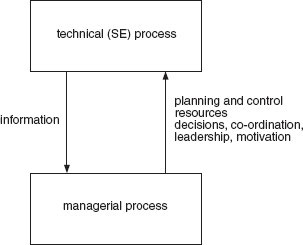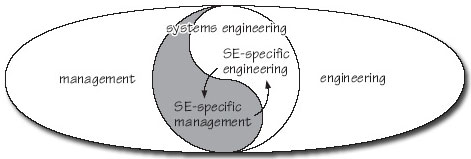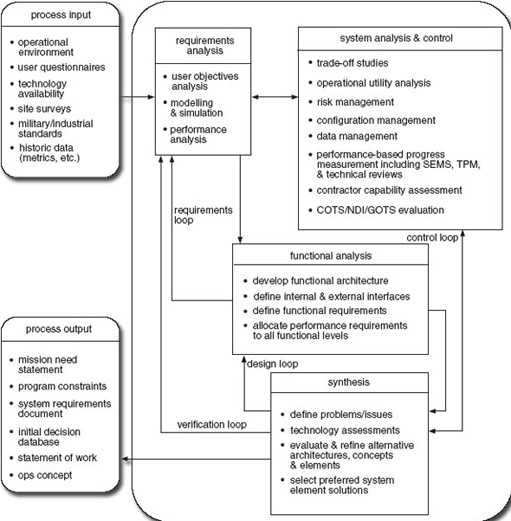5.2 The aims and principles of system engineering
The aims of systems engineering can be divided into those to do with its outputs and those associated with the process itself. As far as its outputs are concerned, systems engineering aims to ensure that:
-
the requirements of all the stakeholders are taken into account in engineering the system
-
the system, as engineered and realised, meets the requirements of stakeholders
-
the system, while meeting the requirements of stakeholders, should be designed and implemented in such a way as to minimise its negative impact on society and the physical environment.
Systems engineering as a process aims to:
-
achieve the realisation of the system within time and cost targets
-
ensure that the realisation of the system is profitable for a business enterprise or effective in a not-for-profit organisation
-
ensure that any risks associated with the realisation of the system are minimised
-
provide a framework in which the combination of all those associated with the realisation of the system is maximised and their professional development furthered
-
provide a process whereby the individual and team learning that takes place during the realisation of the system becomes part of the intellectual capital of the organisation.
There are seven principles of systems engineering.
-
Systemicity: a systems viewpoint is adopted, including, in particular, taking a holistic, balanced approach.
-
Betterment (from definitions of engineering): whatever is done should contribute to the amelioration of the human condition and improve or minimise damage to the sentient and non-sentient environment.
-
Relevance: systems engineering effort is directed towards achieving the wider strategic aims of the organisation.
-
Inclusivity: the requirements of all stakeholders in the system are taken into account in its realisation. This follows from the concept of holism.
-
Comprehensiveness: all the stages of the system's life cycle are addressed.
-
Multidisciplinarity: since systems engineering is concerned with the realisation of complex systems, a balanced contribution from different, appropriate specialist disciplines is required.
-
Personal and team growth and development: systems engineering contributes to the growth of knowledge within the team and organisation.
The aims and principles of systems engineering provide the basis for decision and action. The final element in the general framework used in the course is a division between the technical and managerial components (Sage, 1981; Sage, 1994; Shenhar, 1999). Shenhar represents these two elements with the diagram shown in Figure 48.

Question 5
Look at Shenhar's diagram (Figure 48). What are the main criticisms that might be levelled at it?
Answer
The main criticism that I would make of Shenhar's model is that it seems to imply a separation of the technical and managerial processes. Such a separation is undesirable and may be disastrous. A second objection is that Shenhar's model seems to imply that, while the technical process is specific to systems engineering, the managerial process is generic in character. This criticism may arise from the way that the diagram has been drawn. The text that accompanies the diagram suggests the following as the most common activities of systems engineering managers.
-
The identification of an operational need with an opportunity to create a system to respond to this need.
-
Setting the exact system and functional requirements to ensure the best fit to customer needs.
-
Dividing and allocating the functional requirements into different subfunctions and modes of operation.
-
Choosing the system concept that will best fit these requirements.
-
Designing the system architecture, based on the chosen concept.
-
Dividing the system into separate sub-systems and components to ensure overall optimisation, fewest interfaces, and fewest mutual effects of the various sub-systems.
-
Optimising the specifications of the various sub-systems through simulation, analysis and trade studies.
-
Managing the interaction with various engineering groups that performed the design of the sub-systems while integrating various people and disciplines.
-
Performing the integration of the various sub-systems into a total system.
-
Evaluating the performance and qualifications of the final system through simulation and testing activities.
-
Demonstrating the operating system to customers and convincing them that it responds to their needs.
The following are the technical activities associated with systems engineering (Shenhar, 1999, pp. 116–18).
-
Need identification and customer linkage. To identify the need and the system opportunity by matching need and technical feasibility and be the link bond between customer needs and system idea and design during the entire process of system creation.
-
Requirements management. To develop a set of system and functional requirements based on customer needs.
-
Architecture and system design. To be the lead person in envisioning the system's concept, and to create the link between the system's requirements and the system's configuration.
-
Integration. To see the entire picture and how each part contributes to the performance and feasibility of the system as a whole. Also, to coordinate the work of the various disciplines and professions involved and manage the interfaces among them such that the result is an overall optimal system.
-
Analysis, development and testing. To collect data from various sources, perform modelling and simulation and analyse them as a basis for decision making to confirm that the system is designed to its requirements; and to test and verify that the system built will meet these requirements as designed.
-
Process management. To plan, document, direct and follow the systems engineering process.
-
Technical and risk management. The process of systems engineering involves technical and trade-off decisions and the resolution of technical problems and conflicts at different interface points. These conflicts are primarily professional rather than personal, and reflect the different views of the distinct disciplines involved in creation of the system. This role also involves risk assessment on various system elements and overall risk management during the system creation.
-
Leading, coordinating and managing. In addition to being a technical manager, the systems engineer must be a manager of activities and leader and coordinator of people. The job includes dealing with work plans, schedules, and budgets, but also working with people – organising their work, motivating them, communicating with them, and dealing with their needs.
-
Logistics and operations management. To consider and include maintenance, operation, logistics, and disposal concerns during the requirements, design, and development phases, and to ‘escort’ the users during the operational phase of the system, to ‘break them in’, to answer questions and solve anomalies.
-
Information management. To see the overall information needs of the system, plan the forms and means in which information will be created, disseminated and stored, and direct the process of information sharing and configuration control.
The technical and the managerial have to be seen within the context of the whole that is systems engineering. Its two components rely symbiotically on each other and both are systems engineering specific. The inextricably linked relationship of the technical and managerial are shown at the centre of Figure 49, which also indicates that the two components are special subsets of the wider general subjects of engineering and management.

The INCOSE model of the technical component of systems engineering is shown in Figure 50.

